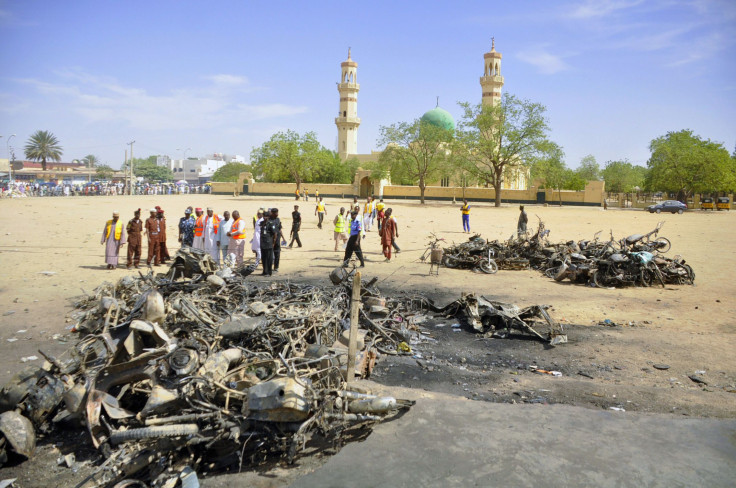Boko Haram In Nigeria: After Baga Massacre, Militant Islamist Group’s Plans Remain A Mystery

It’s been a week since Boko Haram militants carried out their deadliest attack ever in northern Nigeria -- and many details are still unknown. Initially, there were media reports that 2,000 people were killed when dozens of Boko Haram militants stormed the town of Baga, as exemplified by one BBC News account. However, the Nigerian government said the death toll was actually 150, Time reported.
The uncertainty surrounding this incident illustrates one of the major problems associated with Boko Haram. The exact death toll is unknown, but even less is known about the militant group itself. While Boko Haram’s general history and background has been documented, the recent escalation of violent attacks has left many wondering what’s next.
“This is a serious problem, and is seen in the fact that we have to rely on satellite imagery to get some idea on the Boko Haram Baga attack,” said Jas Opperman, South Africa-based analyst at the Terrorism Research and Analysis Consortium, or TRAC.
It wasn’t until six days after the attack that researchers at Amnesty International were able to access satellite photographs that showed how devastated the small border town was -- more than 3,700 structures were burned to the ground. But nobody really knows exactly how many are dead, in hiding or on the run. Despite the dizzying death toll, media coverage was relatively scarce, data was fuzzy and Nigerian officials had a completely different account of what happened.
“Also, the lack of cell phone and social media communication means that we have to rely on media reports and eyewitness accounts -- all of which are totally subjective,” Opperman said.
Although Amnesty International was careful to avoid confirming the number of dead at 2,000, which originally came from a local politician who spoke to BBC News, the group did report that “hundreds” had been killed.
“We’ve spoken to a number of eyewitnesses, people who were in Baga and around the town,” said Daniel Eyre, Amnesty International’s Nigeria analyst. “They were able to give us some testimony about what they saw as they fled the towns themselves. Putting together these statements, we’ve been able to get a sense of the scale of the killing.”
Boko Haram took its current form five years ago, but its roots date back to 2002. That year, Islamist cleric Mohammed Yusuf created a religious group whose goal was the implementation of Shariah, or Islamic law, according to BBC News. Back then, it was called Jama’atu Ahlis Sunna Lidda’awati wal-Jihad, or “People Committed to the Propagation of the Prophet’s Teachings and Jihad.”
Their focused opposition to Western education earned them the nickname Boko Haram. In Hausa, a widely spoken language in Nigeria’s Muslim northern region, this translates roughly to “Western Education Is Forbidden,” as the Christian Science Monitor reported.
While the group was active more than a decade ago, many say it was radicalized in 2009 through a series of events that began with a bike-helmet law, as the Atlantic reported.
That year, the Nigerian government enacted a law that required all motorcyclists to wear helmets in the name of safety. While the ban initially sparked light-hearted protests, many saw it as directly targeting members of Yusuf’s group, who often used motorcycles to get around, as Reuters said.
The tensions between Yusuf’s group and the government came to a head in 2009, when dozens were arrested while riding in a convoy on their way to a funeral for two members who had died in a car crash. According to AllAfrica, the sect members were not pleased, and some reports say they took the arrests as provocation. That was just the first police action against the group. Later, police conducted a raid on one member’s home.
Boko Haram soon retaliated with attacks on police targets, and violence between the two groups escalated, resulting in Yusuf’s death while in police custody.
Groups such as Amnesty International have documented abuses by police officers and soldiers that echo the brutality of Boko Haram, with video evidence that security forces may have committed war crimes including extrajudicial executions and mistreatment of prisoners.
While details of Boko Haram’s finances and resources are murky -- and fraught with rumors of support by local politicians -- many agree the group may have better resources than Nigeria’s military, which is struggling with a lack of will and funds, as demonstrated by CNN’s recent interview with a Nigerian soldier.
The 2009 conflicts between security forces and Boko Haram ended with Yusuf’s death in police custody, after which the remaining group members went underground and emerged the next year under a new leader -- Abubakar Shekau, who led the group in increasingly violent attacks.
“Some might say he’s crazy like a fox,” Max Abrahms, a professor of political science at Northeastern University and a terrorism analyst, said of Shekau. “When political scientists usually talk about terrorist groups, particularly the leaderships of terrorist groups, we usually conceive of them as rational, strategic actors,” he said. “But I think making that case here is a lot harder.”
Abrahms explained that Boko Haram has becoming more and more violent during the past year. After the group kidnapped more than 200 schoolgirls from the town of Chibok in April, a main claiming to be Shekau said in a video he had abducted the girls and would “sell them in the market, by Allah.”
Since May 2011, there have been more than 14,000 Boko Haram-related deaths documented by media sources, according to the Nigeria Security Tracker of the Council on Foreign Relations.
It’s hard to determine what Boko Haram will do in the next few months, but more activity is expected during the coming federal elections in Nigeria, which may be accompanied by an expansion into the neighboring countries of Cameroon and Chad.
© Copyright IBTimes 2025. All rights reserved.






















